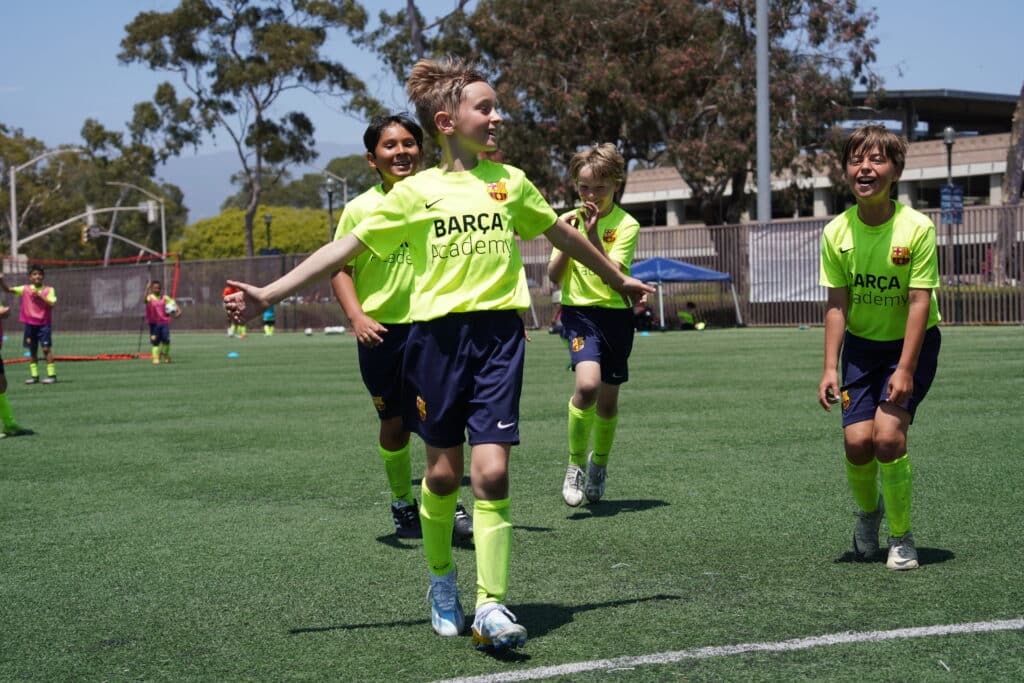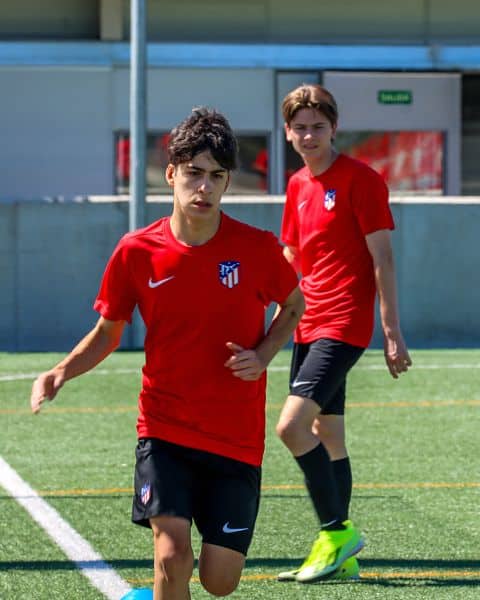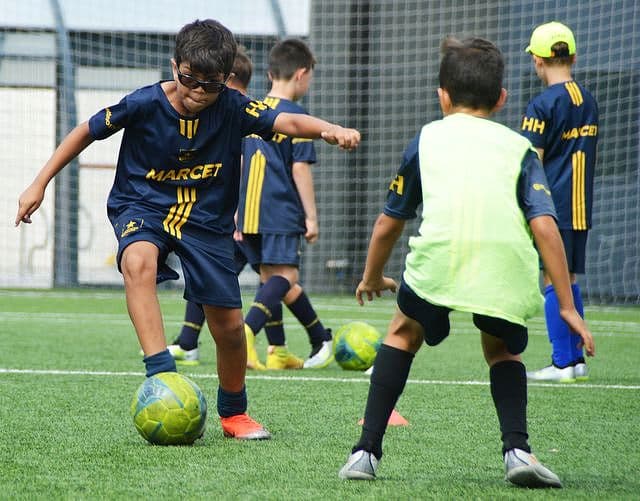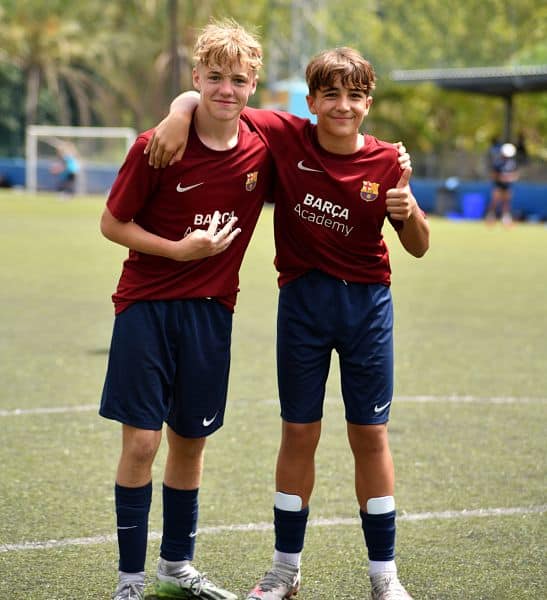Best Soccer Camps in Spain for US Families (2026)
You’ve been thinking: maybe a soccer camp in Spain could be that transformative summer experience that takes my child’s game to another level.
But here’s where it gets complicated. Spain offers literally hundreds of soccer camps, from legitimate professional academies to overpriced tourist traps that slap a famous logo on generic training sessions. How do you tell them apart from 5,000 miles away? Which ones actually deliver on their promises? And practically speaking, how do you navigate the logistics of sending your child overseas for a week or two?
Since 2019, we’ve helped over 2,000 American families navigate European soccer camps through Looking For Soccer. We’ve personally visited these Spanish facilities, talked to coaches, watched training sessions, and collected feedback from hundreds of US parents who’ve sent their kids abroad. This article cuts through the marketing noise to show you exactly which Spanish soccer camps deserve your investment and why.
You’ll discover what separates authentic professional academies from mediocre programs, learn the real costs beyond advertised prices, understand the logistics that trip up most first-time families, and get specific recommendations based on your child’s age, skill level, and what you’re hoping they’ll gain from the experience.

Why Spain Dominates the European Soccer Camp Landscape
Spain isn’t just another European destination for soccer training. It’s become the gold standard for youth development, and the numbers back this up.
The Spanish methodology that changed modern soccer
Spain has produced more Ballon d’Or winners in the 21st century than any other country except Argentina. That’s not luck. It’s the result of a systematic approach to youth development that prioritizes technical mastery, tactical intelligence, and possession-based play. When your child attends a quality Spanish soccer camp, they’re not just training in Spain – they’re absorbing a philosophy that has reshaped how the world plays soccer.
The Spanish system focuses on “rondos” (possession circles), positional play, and building from the back. These aren’t just buzzwords. They represent a fundamentally different way of understanding soccer compared to the more physical, direct style that still dominates much of American youth soccer. A week or two immersed in this methodology can genuinely shift how your child sees the game.
https://looking-for-soccer.com/en-us/soccer-camps-club/fc-barcelona/barca-academy-marbella-spain/Real example: Last summer, a 13-year-old midfielder from Dallas attended FC Barcelona’s academy in Marbella. His father told us that within three days, his son started making different decisions on the field – looking for the third passing option, checking his shoulder constantly, receiving the ball on the back foot. These weren’t things the coaches explicitly taught in drills; they were absorbed through constant exposure to Spanish playing principles.

Infrastructure and weather advantages
Here’s something practical that matters more than most families realize: Spain offers 300+ days of sunshine annually in regions like Andalusia and Valencia. Your child isn’t losing training days to rain or extreme heat. The consistency of weather means camps can deliver exactly what they promise – no indoor backup sessions that compromise quality.
The infrastructure edge extends beyond weather. Spain invested heavily in sports facilities over the past two decades. Many camps operate in purpose-built soccer complexes with multiple full-size pitches, individual changing rooms, recovery pools, and sports science facilities. Compare that to camps in other European countries that might rent school fields or municipal facilities for a week. The quality difference shows immediately.
Cultural immersion that enhances the experience
Your child won’t just train in Spain – they’ll live it. Morning trips to local bakeries for authentic Spanish breakfast, evenings watching actual La Liga matches in neighborhood bars filled with passionate locals, excursions to Camp Nou or Santiago Bernabéu that go beyond tourist snapshots. This cultural dimension transforms a soccer camp into a broader educational experience that stays with kids long after they return home.
And Spanish people genuinely love soccer in a way that feels different from sports enthusiasm in the US. When your child walks around Barcelona or Madrid wearing training gear, locals engage them in conversations about the game. This organic interaction with a soccer-obsessed culture can deepen your child’s connection to the sport in ways that purely technical training never achieves.
Top Spanish Soccer Camps for American Families: What Sets Them Apart
Not all Spanish camps deliver equal value. Here’s what actually separates the elite programs from the rest, based on our seven years of observation.
Professional club academies vs independent programs
The big decision: official club academy or independent soccer school? Both have merits, but they serve different purposes. Club academies like Atlético Madrid’s official programs provide brand prestige, access to first-team facilities, and coaching staff directly employed by professional clubs. Your child trains where the pros train, using the same methodologies.

Independent academies like Marcet Academy or Soccer Inter-Action in Valencia often provide more personalized attention with smaller group sizes. They’ve built their entire business around youth development rather than running camps as a secondary revenue stream. Many employ former professional players as full-time coaches rather than seasonal staff.

Which matters more for your child? If they’re deeply invested in a specific club – say they’ve been a Barcelona fan since age six – the emotional value of training at Camp Nou facilities might justify the premium price. If development and individual attention matter more, independent academies frequently deliver better coaching ratios and more customized feedback.
Residential vs day camp considerations for international families
Most American families opt for residential programs since you’re already dealing with international travel. But this decision deserves more thought than it typically gets. Residential camps (called “internship” or “boarding” programs in Spain) provide 24/7 immersion with built-in supervision, meals, and activities. Your child lives and breathes soccer from wake-up to lights-out.
Day camps work if you’re planning a family vacation in Spain anyway. You drop your child off at 9 AM, pick them up at 5 PM, and spend evenings together exploring Spanish cities. Programs like Kaptiva Sports Academy in Barcelona offer both options, giving families flexibility based on their travel plans.
The residential experience typically costs $500-800 more per week but includes accommodation, three meals daily, and evening activities. When you factor in hotel costs for the family, the residential premium often makes financial sense while providing your child with the full immersion experience.
Coaching credentials that actually matter
Here’s what to look for: UEFA licenses. The European coaching certification system is far more rigorous than US equivalents. A UEFA B license requires 120 hours of coursework and practical assessments. UEFA A demands another 180 hours plus proven coaching experience. Camps staffed primarily with UEFA B-licensed coaches or higher demonstrate serious commitment to coaching quality.
Ask specific questions: What percentage of coaches hold UEFA licenses? Are they full-time academy staff or seasonal hires? Do they speak English? (Most quality Spanish camps now employ bilingual coaches or provide translators, but verify this upfront.) Elite programs like ProFutCamps in Madrid typically maintain 1:12 coach-to-player ratios with all lead coaches holding minimum UEFA B credentials.
Red flag: camps that won’t provide specific coach information or hide behind vague statements like “experienced professional coaches.” Legitimate programs showcase their coaching staff proudly because quality educators are their main competitive advantage.
Practical Logistics That Make or Break the Experience
The soccer training itself might be fantastic, but poor logistics can ruin the entire experience. Here’s what seven years of helping American families has taught us.
Flight routing and arrival coordination
Most Spanish camps operate near Barcelona, Madrid, Valencia, or Málaga – all served by direct flights from major US hubs. Barcelona and Madrid get multiple daily directs from New York, Miami, and Los Angeles. Málaga (serving Marbella camps) requires a connection through European hubs but still offers convenient access.
Camp start times matter more than you’d expect. Many programs begin Sunday evening with registration and orientation. That means your child needs to arrive Sunday afternoon, which limits flight options if you’re coming from the West Coast. Factor in time zone adjustment – Spain is 6-9 hours ahead of US time zones depending on where you live. Arriving Saturday gives your child 24 hours to adjust before training starts Monday morning.
Airport transfer arrangements separate professional operations from amateur ones. Quality camps include airport pickup in their pricing or offer it as a reliable paid add-on. They track your child’s flight, adjust for delays, and have staff waiting at arrivals with name signs. Budget camps might give you a local taxi number and wish you luck. This matters tremendously when you’re trusting someone else with your child’s safe arrival.
Documentation requirements for minors traveling internationally
US citizens need a passport valid for at least six months beyond their stay. Spain waived visa requirements for American tourists staying under 90 days, but you’ll need additional documentation for unaccompanied minors. Every child under 18 traveling without both parents requires a notarized parental consent letter authorizing the trip.
The letter should include: child’s full name and date of birth, parents’ full names and contact information, trip dates and destination, accompanying adult information (if applicable), and both parents’ notarized signatures. Spanish immigration rarely asks for this document, but airlines frequently do at check-in – and they’ll deny boarding without it. Get it notarized at least two weeks before departure to avoid last-minute stress.
Health insurance presents another logistical hurdle. Your US health insurance probably doesn’t cover medical care in Spain. Most quality camps require proof of international health coverage. You can purchase short-term international health insurance for $50-100 per week through providers like IMG Global or Seven Corners. This isn’t optional – accidents happen, and you want your child covered if they need medical attention.
Communication and monitoring during the camp
Here’s what keeps most parents awake at night: What if something goes wrong and I can’t reach my child? Reputable camps provide daily updates through WhatsApp groups or private portals where they post photos, videos, and brief summaries of each day’s activities.
Phone policies vary considerably. Some camps allow children to keep phones with agreed-upon usage times (typically evenings after dinner). Others collect phones during training days to minimize distractions. Know the policy before your child leaves so you can set appropriate expectations. Nothing creates more homesickness than a child expecting to text you anytime but discovering phones are locked away until evening.
Emergency contact protocols matter critically. The camp should provide you with a 24/7 emergency phone number answered by English-speaking staff. Test this number before your child leaves. Send a text asking a simple question and see how quickly they respond. Camps with professional operations reply within an hour during business hours. Those that take days to respond or never answer raise serious red flags.
Age-Specific Recommendations: Finding the Right Fit
A camp perfect for your 15-year-old might overwhelm your 10-year-old. Here’s how to match programs to developmental stages.
Younger players (ages 8-12): Foundation and fun
For this age group, technical development and positive experiences matter more than tactical sophistication or intensity. Programs like ProFutCamps in Marbella excel with younger players by maintaining high energy, incorporating games into drills, and ensuring every child touches the ball constantly.
Look for camps with specific age-appropriate programming rather than mixed-age sessions where your 10-year-old shares the field with 16-year-olds. The best programs group by age and ability, ensuring appropriate competition and challenge levels. Younger players need more repetitions of fundamental techniques – passing, receiving, dribbling, shooting – without getting lost in complex tactical discussions they can’t yet process.
Cultural activities and excursions become especially important for this age group. A full day at PortAventura theme park or a beach afternoon breaks up the soccer routine and keeps younger kids engaged. Camps that schedule nothing but soccer for seven straight days often see younger children lose enthusiasm by midweek. Smart programs build in variety while maintaining focus.

Teen players (ages 13-17): Intensity and specialization
Teenagers can handle – and benefit from – more demanding programs. They possess the physical capacity for high-volume training, the cognitive development to understand sophisticated tactics, and often the motivation to push themselves harder. Programs affiliated with professional clubs tend to suit this age group better because they replicate professional intensity levels.
Position-specific training becomes relevant for teens. Camps offering specialized goalkeeper sessions, striker clinics, or defensive workshops allow teenagers to dive deep into their positional requirements. FC Barcelona’s Marbella academy runs position-focused afternoons where players work exclusively on role-specific skills with specialized coaches – something younger players don’t yet need but teenagers often crave.

For highly competitive teens with academy or varsity experience, consider camps that include scrimmages against local Spanish youth teams. These matches provide genuine competition against players raised in Spanish soccer culture, offering a reality check about where your child stands internationally. Some camps even include showcase events attended by scouts, though you shouldn’t expect or promise recruitment – view it as a bonus if it happens rather than the main objective.
Cost Breakdown: What You’re Actually Paying For
Let’s talk money. Spanish soccer camps range from around $1,000 to $4,000 once you factor in everything. Here’s where your money goes and what constitutes fair value.
Base camp fees and what they include
Weekly camp tuition typically runs $800-1,500 for residential programs. This should include all training sessions (usually 15-25 hours weekly), coaching, field rental, equipment except personal gear, accommodation in double or triple rooms, three meals daily, and basic excursions like stadium tours. Day programs cost $400-700 weekly since they exclude housing and most meals.
Higher prices don’t automatically mean better quality, but extremely cheap camps almost certainly cut corners somewhere – coaching quality, facilities, supervision, or safety protocols. When camps advertise prices below $800 for full residential programs, dig deeper into exactly what’s included and what costs extra.
Watch for hidden fees that inflate total costs: airport transfers ($50-150 each way), laundry service ($30-50 per week), optional excursions ($50-200), training gear packages ($100-200), photo/video packages ($75-150). These add-ons can easily push total costs up another $500-800 beyond base tuition. Request an all-in cost estimate before committing so you’re not surprised by charges during or after the camp.
International travel expenses
Round-trip flights from the US to Spain vary wildly by departure city and booking timing. East Coast families can find directs to Madrid or Barcelona for $500-800 round-trip if booked 3-4 months ahead. West Coast flights typically run $700-1,200. Summer peak season (July-August) commands premium pricing, so consider late June or late August camps for better airfare rates.
Unaccompanied minor fees add another layer of expense. Airlines charge $50-150 each way for unaccompanied minor service (required for most carriers until age 15), which includes escort assistance and priority boarding. Some families avoid this fee by having an older sibling (age 16+) accompany younger children, though this requires both attending the same camp or making other arrangements for the older child.
What Your Child Actually Gains: Setting Realistic Expectations
Let’s address the elephant in the room: Will this camp turn your child into a professional player? Almost certainly not. But that doesn’t mean it won’t deliver tremendous value.
Technical development and tactical understanding
A week or two of intensive Spanish training won’t magically transform a mediocre player into a star. But it can genuinely improve specific technical elements and tactical concepts. Spanish coaching emphasizes details American coaches often overlook – body positioning when receiving passes, checking shoulders before touching the ball, understanding spatial relationships and positioning.
Parents consistently report that their children return with improved first touch, better decision-making speed, and enhanced positional awareness. These improvements don’t happen because Spanish coaches possess secret training methods. They happen because quality programs provide 20-25 hours of training per week (versus 3-6 hours in typical US club soccer) with higher coaching expertise and better player-to-coach ratios.
The tactical education particularly stands out. Spanish coaches teach “why” as much as “how.” Your child learns why they should position themselves in certain spaces, why specific passing patterns create advantages, why building from the back works better than launching long balls. This tactical education changes how they see soccer even if their technical execution takes longer to improve.
Confidence and independence building
Many American parents tell us the personal growth exceeded the soccer development. Your 13-year-old navigates international airports, lives with strangers for two weeks, solves problems without parental intervention, and survives in an environment where they might not speak the language fluently. These experiences build confidence and independence in ways suburban American life rarely provides.
Living in residential programs, children manage their own laundry, organize their belongings, wake themselves up on time, and negotiate social dynamics with peers from different countries and cultures. Some struggle initially – we hear about homesickness during the first few days – but most adapt quickly and emerge with newfound maturity. Multiple parents have told us their children returned from Spanish camps noticeably more responsible and self-sufficient.
Realistic career pathway information
For families harboring professional aspirations, Spanish camps provide a valuable reality check. Your child trains alongside and against players from genuine academy backgrounds – kids who’ve been in professional development systems since age 7-8. This exposure helps families understand where their child actually stands on the global talent spectrum.
Sometimes this reality check disappoints. Parents realize their child, while good locally, isn’t at professional development level. That’s valuable information that saves years of unrealistic pursuit and allows the family to reframe soccer as an enriching part of life rather than a potential career. Other times, children hold their own against academy competition, validating professional pathway aspirations and motivating continued high-level pursuit.

Making Your Decision: A Step-by-Step Selection Process
You’re sold on the idea of a Spanish soccer camp. Now comes the hard part: choosing specifically which program best fits your child and family circumstances.
Step one: Assess your child’s readiness
Start with honest conversation. Does your child actually want to attend a Spanish camp, or are you pushing the idea? Forced participation rarely ends well. Ask them about their comfort level spending two weeks away from home in an unfamiliar environment. Discuss their ability to handle language barriers, new foods, different coaching styles, and potential homesickness.
Evaluate their current commitment level. If your child only casually enjoys soccer – shows up to team practice but doesn’t play on their own time – an intensive Spanish camp might feel like punishment rather than opportunity. These programs work best for kids who genuinely love soccer and already demonstrate self-motivation to improve.
Consider timing within their development. The ideal window typically falls between ages 12-16 when children are mature enough to handle independence but still absorbent enough to integrate new technical and tactical concepts. Younger kids often gain more from domestic camps closer to home, while older teens (17+) might benefit more from college ID camps if they’re pursuing college soccer.
Step two: Match programs to specific goals
Define what you’re hoping this experience delivers. Cultural immersion and personal growth? Technical improvement? Exposure to professional environments? Validation of competitive level? Different camps excel at different objectives, so clarity about priorities guides selection.
Families prioritizing cultural experience might prefer programs with extensive excursions and free time to explore Spanish cities. Those focused on intensive development should seek camps with maximum training hours and minimal distraction. Prestige-seekers want official club academies with name recognition. Budget-conscious families need to identify programs offering strong value without premium pricing.
Looking For Soccer’s platform allows you to filter by these specific criteria – age ranges, training intensity, accommodation type, club affiliation, location, and price point. We’ve personally evaluated every Spanish camp we list to ensure they meet baseline quality standards, so you’re choosing among legitimate options rather than filtering through hundreds of questionable programs.
Step three: Verify logistics and support
Before making final payment, confirm every logistical detail. Get written confirmation of airport transfer arrangements including pickup time, meeting location, and driver contact information. Verify accommodation specifics – room setup, bathroom arrangements, security measures. Confirm meal plans address any dietary restrictions your child has.
Request references from other American families who’ve recently attended. Legitimate camps happily connect prospective families with past participants. Ask these families about their child’s experience, whether reality matched marketing promises, how the camp handled any issues that arose, and whether they’d send their child again.
Check cancellation and refund policies carefully. What happens if your child gets injured two weeks before departure? If the camp cancels? If your child arrives and hates it after two days? Reputable programs offer reasonable cancellation windows (typically 30-60 days before start date) and clear refund structures, even if those refunds are partial rather than complete.
Spanish soccer camps offer American families something genuinely special: authentic immersion in the world’s most successful player development system, cultural experiences that broaden perspectives beyond soccer, and the kind of independence-building adventure that stays with young people for life. But only when you choose the right program and prepare properly.
The camps we’ve highlighted – from FC Barcelona’s Marbella academy to independent programs like Marcet and Soccer Inter-Action – represent tested quality that consistently delivers on their promises. They’re not the only good options in Spain, but they exemplify the standards you should demand: professional coaching credentials, purpose-built facilities, transparent pricing, proven track records with international families, and comprehensive support systems that keep parents informed and children safe.
Your next step? Get specific about your child’s readiness, clarify your family’s primary objectives, review the programs we’ve linked throughout this article, and reach out to Looking For Soccer if you need personalized guidance. We’ve helped thousands of American families navigate exactly this decision since 2019, and we’re here to ensure you find the Spanish soccer camp that transforms your child’s summer into something extraordinary.
